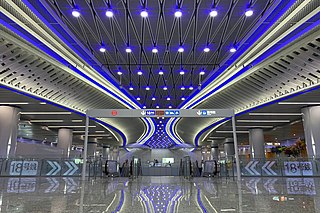The Chonghai Bridge is a proposed bridge to span the northern distributary at the mouth of the Yangtze River in the People's Republic of China. The bridge, along with the Chongqi Bridge and the Shanghai Yangtze River Tunnel and Bridge, is to connect the city of Shanghai with the north bank of the Yangtze in Jiangsu Province via Chongming Island.

Maiji District is a district of the prefecture-level city of Tianshui in the southeast of Gansu Province, China, bordering Shaanxi Province to the east. It is best known for, and named after, the Maijishan Grottoes. Before 2005 it was called Beidao District.

Line 3 of the Guangzhou Metro is a 65.43-kilometer (40.66 mi) rapid transit line connects Panyu Square to Tianhe Coach Terminal. The entire line, including all track and stations, is located in tunnels. Its 57.93 km (36.00 mi) main branch, excluding the 7.5 km (4.66 mi) branch between Tianhe Coach Terminal and Tiyu Xilu, is now the third longest continuous subway tunnel in the world, and the longest rail tunnel of any kind.

Tanwei Station, formerly Datansha South Station and Datansha Station during planning, is an elevated station on Line 5 of the Guangzhou Metro and an underground station on Line 6. It is located at Zhongshuangqiao Park (中双桥公园) on Datansha Island in the Liwan District. It opened on 28 December 2009. It became an interchange station between Line 5 and Line 6 on 28 December 2013.

Tianxin District is one of six urban districts of the prefecture-level city of Changsha, the capital of Hunan Province, China. The district is bordered by Yuetang District of Xiangtan to the south, Yuhua District to the east, Furong and Kaifu districts to the north, Yuelu District across the Xiang river to the west. Located in the southern central Changsha, Tianxin covers 141.05 km2 (54.46 sq mi) with population of 604,600. The district has 14 subdistricts under its jurisdiction, its administrative centre is at Qingyuan Subdistrict.

The Wuhan–Jiujiang railway or Wujiu railway, is a double-track, electrified railroad in central China between Wuhan in Hubei Province and Jiujiang in Jiangxi Province. The line is 258 km (160 mi) long and follows the south bank of the Yangtze River from Wuchang District in Wuhan to Lushan Station in Jiujiang. Major cities and towns along the route include Wuhan, Huarong, Huanggang, Ezhou, Huangshi, Daye Yangxin, Ruichang and Jiujiang.

Guangzhou No.2 High School is a Chinese public high school in Guangzhou, Guangdong. The school was established in August, 1930.
The Wuhai Yellow River Road Bridge is located in Wuhai, Inner Mongolia. The cable-stayed bridge's main span length is 760 m (2,490 ft); The total spanned length is 1,130 m (3,710 ft). As of 2022 it is the bridge over the Yellow River with the largest single structure span. Each of the bridge's tower is 50 m (160 ft) tall.

Line 18 of the Guangzhou Metro is a rapid transit express line in Guangzhou with trains operating up to 160 km/h (99 mph). It will run in a south-north direction, connecting Wanqingsha in Nansha District, Panyu Square in Panyu District, Modiesha in Haizhu District, Zhujiang New Town and Guangzhou East Railway Station in Tianhe District. The line commenced service on 28 September 2021.

Line 22 of the Guangzhou Metro is a partially open rapid transit express line in Guangzhou with trains operating up to 160 km/h (99 mph). It runs between Panyu Square and Chentougang, passing Guangzhou South Railway Station in Panyu District, and will eventually run in a north-south direction passing Xilang and Fangcun in Liwan District. Currently, there are train attendants on board each train. In the future, trains will operate fully driverless GoA4 mode when sufficient reliability from the signaling system has been confirmed.

Yinchuan railway station is the main railway station of Yinchuan, the capital of China's Ningxia province.
Shuqian Lu station is a planned station of Line 10 of Guangzhou Metro. It is planned to be built underground on the north side of Miaoqianzhi Street in Yuexiu District, near Dongshankou station. Due to the lack of transparency of the planning process and the site selection of Dongshan, the historical core area of Guangzhou, this site has caused controversy and attracted much attention.

Guangzhouchanglong railway station is a station on Foshan-Dongguan intercity railway located in Panyu District, Guangzhou, Guangdong, China. The station was officially named as Guangzhouchanglong railway station in November 2020. The railway station opened on 26 May 2024.

Wanqingsha Station is a station on Line 18 of the Guangzhou Metro, located underneath Nansha railway station in Guangzhou's Nansha District. It opened on 28 September 2021, and is the current southern terminus of the line.
The G7013 Shaxian–Nanping Expressway, also referred to as the Shanan Expressway, is an under construction expressway in Fujian, China that connects Shaxian to Nanping via Shunchang County. The expressway was originally numbered as Fujian Provincial Expressway S20 during the planning stage.

On 22 February 2024, a barge collided with the Lixinsha Bridge in Guangzhou, Guangdong, China, causing a portion of the bridge to collapse. Two vehicles plunged into the river and three others fell onto the barge, leaving five dead and three others injured.













